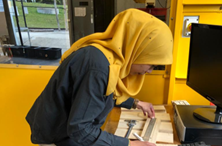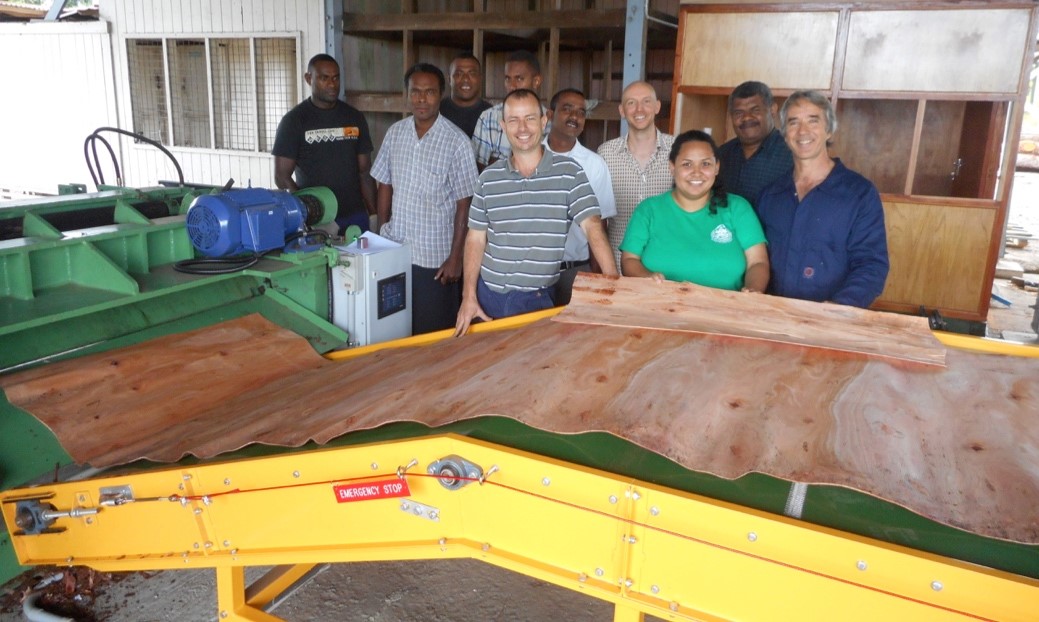Robust and long-lasting timber-rich buildings and structures require innovative products drawn from Australia’s available forest resources.
Resource efficiency and the circular economy require that as much of this resource as possible is effectively converted into useful materials.
Our team provides research and development services covering:
- Board processing and drying.
- Resource characterisation.
- Engineered wood product manufacture and optimization.
- Production recovery and improvement.
- Moisture content management.
Projects

Supervisors: Dr Kyra Wood
Timber can be prone to defects induced by the drying process, such as warping, dimensional distortion, splitting/checking and discoloration. These defects are primarily introduced when drying occurs under non-ideal conditions. The purpose of this research is to utilize both rack survey data and hygrothermal software methods to understand and therefore predict the cause of several types of discoloration defects and establish ideal drying conditions for the mitigation or elimination of those defects.

Supervisors: Dr Kyra Wood
NIF078 will test the feasibility of commercial scale treatment and modification of eucalypt wood panel samples and sawn boards to improve their durability and fire resistance. The research aims todetermine impediments to wood product chemical treatment uptake, and test for characteristic improvements and/or deterioration in the treated samples in order to support timber processors to potentially utilise lower grade logs for easy-to-manufacture products that meet durability and fire resistance regulated requirements.

There is an expanding regional and international market for wood veneers and composite wood products. As access to the traditional resources for these products, particularly tropical rainforests, are constrained, an opportunity exists for the Pacific’s estimated 120,000 hectares of senile coconut plantations to become an attractive alternative resource.
The ACIAR-funded project aims to develop the technologies, processes and expertise to produce high-quality veneer and complementary soil conditioning products from senile coconut stems and thereby enhance livelihoods in South Pacific communities. Its specific objectives are to:
- Identify the most promising product options for the veneer from coconut stem.
- Develop protocols and capacity for sustainable low-impact coconut wood harvesting, plantation rehabilitation, and log grading, handling and transport.
- Establish experimental veneer-peeling capacity in the South Pacific.
- Determine the optimum processing parameters and protocols for peeling coconut stems and the properties of the recovered veneer.
- Assemble the product suite and establish its characteristics and in-service performance. Characterisation would be to local and export performance standards.
- Determine the costs and benefits of using the residual cortex and soft, central cores for bio-char and other agricultural products.
An initial ACIAR project, FST/2004/054 Improving value and marketability of coconut wood, demonstrated the technical and economic feasibility of milling the stems of senile coconuts to produce high-density coco-wood timber for laminated flooring and other products. This new project will extend the results achieved in the initial project and focus on the potential of producing cocowood veneer products in resource-rich areas around the Pacific.
The key research and development questions critical to establishing a sustainable cocowood veneering industry are:
- Can coconut wood logs be peeled into marketable veneer using spindle-less lathes and can it be peeled, dried and handled efficiently and effectively?
- Can products made from this veneer satisfy the performance requirements established in likely local and export markets?
- Can viable uses be found for the considerable amounts of residual material and by-products generated from this process?
- Can the whole process cycle of harvesting and reestablishment, log supply, milling, and marketing be sufficiently refined to ensure that it is economically robust, and sustainable given the necessary cultural, social and environmental dimensions that exist in the Pacific?

This project was Australia’s first large-scale peeling trial for plantation E. nitens. This species makes up most of Tasmania’s plantation hardwood resources. For the project, plantation pulp logs of different ages were selected from forests around the state, peeled in a state-of-the-art industry facilities, assembled into plywood and the resultant material assessed.
The project was design to provide baseline data on veneer quality and plywood properties of fibre-managed plantation E. nitens grown in the state. It also sought to identify the genetic parameters that affect quality of rotary-peeled veneer and plywood to guide selection of families for future breeding programs and to examine the compatibility of breeding for potentially conflicting objectives; and assess the effectiveness of an acoustic sorting strategy and potential gain from segregation of logs for veneer and plywood production.
The project provided significant baseline information on plywood properties and veneer quality and the genetic parameters that underpin them, and likely modifications needed to current forestry and industry production practice. It found that:
- The recovery of fibre managed E. nitens into face grade material suitable for plywood was zero, making it unsuitable as a stand-alone plywood resource.
- Viable processing of short-rotation (16yr) unpruned E.ni will depend on increasing average stiffness properties through genetic selection of superior families, use of acoustic sorting strategies, process optimisation and stiffness grading and alignment of veneers in panel construction.
Estimates of genetic correlations indicated that breeding programs that have improved pulp yields in plantation E. nitens have also improved desirable properties for RPV engineered wood products.
High stiffness and strength values for E. nitens 26yr plywood panels, suggest opportunities for E. nitens resource on longer rotations.
This National Institute for Forest Products Innovation (NIFPI) project aimed to investigate and advance the durability testing process itself, rather than develop or investigate a new treatment. It builds on certified, well-understood accelerated testing approaches to increase their applicability in the Australian timber industry context.
The project’s objective is to establish and benchmark commercially viable durability assessment techniques suitable for use with collapse-prone hardwoods used in Australian conditions primarily for external cladding applications.
A secondary aim and important part of this research project is to review treatment strategies for selected, representative species, outline how that may impact the accelerated durability testing process and support the development of solutions as needed. Contracted in second half of 2019, the project ended in June 2022.
Significant outcomes from the research include:
- Establishment of a long-term (thirty year) field trial site in northern Tasmania that will be monitored and maintained by researchers at the Centre for Sustainable Architecture with Wood at the University of Tasmania, with matching material in a sister site at the Queensland Department of Agriculture and Fisheries Maroochy Research Station in Nambour, Queensland, that will be monitored and maintained by the National Centre for Timber Durability and Design Life at the University of the Sunshine Coast
- Multiple accelerated and mid to long-term field trials on treated and untreated material installed
- Improved capacity at the University of Tasmania’s Centre for Sustainable Architecture with Wood to maintain, add material to, and collect data from the field trials
- Successful treatment and retention of biocides in the heartwood of Tasmanian plantation shining gum using supercritical carbon fluids (SCFs) as a carrier
- Iterative improvements on the use of conventional vacuum pressure impregnation (e.g. schedules, pressures) and a common preservative chemical (alkaline copper quaternary) in treating Tasmanian hardwoods of varying thicknesses
- Successful development of an accelerated decay chamber set up (i.e. using vermiculite bags) for larger scale samples in a laboratory-based setting
- Establishment of a PhD project at the University of the Sunshine Coast with aim to accelerate decay testing and durability analysis in treated refractory Tasmanian hardwoods
This National Institute for Forest Products Innovation (NIFPI) project aimed to generate and distribute informed industry guidance on best practice for the economic and effective moisture content (MC) control of timber and wood products in the Australian timber supply chain.
It focuses on understanding and providing guidance on managing the MC conditions that timber and wood products are exposed and react to in the timber supply chain, in the wood distribution network, at construction sites, and in-service in operational buildings. As timber and wood products are stored and used in numerous workplaces, sites, and buildings, the methodology concentrates on areas of known product loss or risk and aims to identify necessary and effective preventative action. Contracted in second half of 2019, the project ends in June 2022.
Project deliverables include:
- Review of MC problems and influencing factors.
- Static sample monitoring component.
- Monitoring of timber’s MC content in the supply chain under varying wrapping conditions
- Supply chain, building site, building and species assessments and subsequent risk modelling for the economic and effective MC control of timber and wood products in the timber supply chain
The methodology covers the broad wood product suite at the major stages of the supply chain in representative areas of Australia. The wood products studied include: Australian produced native forest hardwood; plantation pine and hardwood; LVL; and native forest hardboard. The supply chain stages studied include the distribution network; the construction phase; and in-service. The areas studied include National Construction Code (NCC) climate zones (CZ) 7 Tasmania; CZ 6 Melbourne; CZ5 Sydney, Adelaide and Perth; and CZ2 Brisbane.